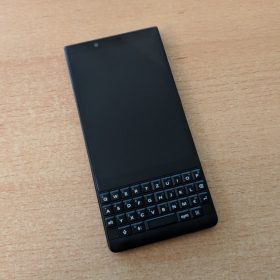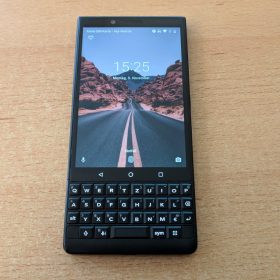Many have declared BlackBerry dead in recent years with statements such as: "no innovations", "who still needs keyboard smartphones", "outdated operating system" but in fact, the manufacturer still exists, learned from many mistakes and also shrunk healthy. In the meantime they have established themselves on the market thanks to the help of the new producer "TCL" and offer great smartphones with Android operating system.
Directly from BlackBerry the current KEY2 reached me and I have tested it extensively in Bloggereinsatz and would like to share with you, my experiences to this device.
Appearance and workmanship
The Smartphone, is delivered in a very stylish cardboard box, which at first glance would like to demonstrate a high quality, which is already good sound with many manufacturers. In addition to the actual smartphone, headphones, USB Type C cable, power supply and instructions are also included. The KEY2 is very different in appearance from common mobile phones, because below the 4.5 inch display is the famous BlackBerry keyboard. It has some very special features that I will explain later. With the dimensions of 151.4mm x 71.8mm x 8.5mm it is still quite big.
The KEY2 has a rubberized back, which lies good and stable in the hand. At the top in the left corner is the DualLens camera, next to it is the Dual Flash. The camera looks a bit out of the case, but still looks harmonious with the case and doesn't stand out enormously. The corners, which are less round than on other devices but not quite as extreme as on Sony, are conspicuous on the case. The complete edge is made of metal. On the left side (seen from the back), there is the volume rocker, underneath the ribbed power switch and a freely assignable button. All buttons are made of metal and have a good pressure point. At the upper edge a 3.5mm jack plug is installed, at the right edge the slot for the Sim card as well as for a MicroSD card, at the lower edge the USB-Type C connector and the speaker outputs are located.
Display
The 4.5 inch IPS LCD panel has a resolution of 1620x1080 pixels, which corresponds to a pixel density of 434 ppi. The display shows very natural colors, but weakens with black tones and also the brightness is only in the lower midfield. In direct sunlight, I could hardly read anything from the display, this is made more difficult by the large number of fingerprints that always magically attract to the touch displays. In general, however, the performance is good and suitable for everyday use.
Processor and Performance
BlackBerry uses the middle class processor Snapdragon 660 from Qualcomm for the KEY2. The device comes with 6GB Ram and 64GB internal memory (expandable with 128GB memory cards). Thus, the device is well equipped for most tasks and fast, the processor does weaken in modern games, but the device is generally not meant for that. Here, the target group is defined directly, which is perfectly ok.
Screenshots benchmark results:
A customized Android 8.1 is used on the device, which will be developed directly at BlackBerry in Canada with numerous additional functions and security features for business users, or anyone who is looking for more security. For example, the secure BlackBerry Messenger is on board as well as apps like "Privacy Shade" and "Redactor" to make trustworthy information unrecognizable or to protect your informations for curious readers on the train. Unfortunately, some of the apps are not explained very clearly or are only poorly integrated into the system, so it takes some time to familiarize yourself with them or to set them up for the first time. I like the laterally extendable additional menu with quick functions like notifications, calendar or frequently used apps.
Screenshots interface:
Input and control
A rather rare category in my test reports, but absolutely necessary with this device. The KEY2 has a built-in hardware keyboard with countless great possibilities. The keyboard reacts quickly to inputs and the user gets a haptic feedback through the pressure point. This enables relatively fast typing with few errors, but requires a lot of time for the operator to get used to the keyboard. Keys are assigned several functions, similar to the "FN" function on PC keyboards. These can be reached via the "Alt" key. Speed buttons can also be specified to start certain apps. The setup is a bit tough, but works otherwise problem-free. In addition, the entire keyboard is touch sensitive and works similar to the touch display only slightly less precise due to the sublimity of the keys. Thus the keys can be used as an "extended touch display" or to avoid fingerprints on the screen.
The space bar is also a fingerprint sensor that works amazingly well and fast.
camera
The built-in DualLens camera offers two sensors as well as different focal lengths for the lenses used. The normal focal length has an aperture of f/1.8 and 12 MP, the telephoto camera an aperture of f/2.6 and also 12 MP. In daylight, good photos are possible, at dusk or in darkened rooms, the combi quickly reaches its limits. BlackBerry has improved here with some updates but the cameras stay behind the flagship devices of other manufacturers. Video recordings are possible with 4K and 30fps, 1920x1080 with 60fps and 720p with 120fps.
For the front or selfies, an 8MP camera is available on the front which produces quite respectable photos.
Connectivity and connections
BlackBerry plays its trump card in this category. All important bands in Germany are supported and the telephony function runs perfectly with good acoustics. Fans of DualSim phones, but have to bite the bullet, and fall back on the slightly more expensive version of the KEY2 with 128GB memory, this offers the possibility to use two SIM cards. The Key2 supports LTE Cat-11 (download up to 600 Mbit/s, upload up to 50 Mbit/s), Bluetooth 5.0, GPS and Glonass and dual-band WLAN ac. An FM radio and an NFC module are also on board.
Battery and runtime
The battery with its 3.500mAh, is very persistent and can easily last a whole day even with frequent use. With normal or less intensive use there are 2 days inside. For me, the phone lasted 9 hours with the display permanently on and the video running.
Thanks to Qualcomm QuickCharge, the phone is fully charged in about 70 minutes.
Sound & Acoustics
The loudspeakers provide a pleasant sound at normal volume, but bass is a tragedy here as well. Only at high volumes do the tones creak and appear very tinny, fortunately a 3.5mm jack plug for headphones is available, which has a good output power. The included headphones have a good sound, only the cable looks a bit cheap.
[letsreview postid="2612"]
| Display | 11,4 cm (4,5 Zoll) IPS resolution: 1080 x 1620 Pixel (433 ppi) protection: Gorilla Glass |
|
|---|---|---|
| Operating system | Android 8.1 (Oreo) | |
| CPU | Qualcomm, Octa-Core (64 Bit) 1. CPU: Snapdragon 660, 4 x 2,20 GHz 2. CPU: Snapdragon 660, 4 x 1,80 GHz |
|
| Memory | 6,0 GB RAM 64,00 GB oder 128GB GB Expandable with microSD-Card, microSDHC-Card, microSDXC-Card up to 256.0 GB |
|
| Data transfer | EDGE, HSPA+ (42,00 MBit/s), LTE (600,00 MBit/s), WLAN, Bluetooth | |
| SIM card type: | Nano-SIM (128GB variant with DualSim) | |
| mobile telephony (MHz) | GSM | 850, 900, 1800, 1900 |
| UMTS | 850, 900, 1700, 1900, 2100 | |
LTE (Band)
|
||
| Main camera | Dual camera: 12.0 megapixels + 12.0 megapixels | |
| Front camera | 8.0 megapixels (3 264 x 2 448 pixels) | |
| Dimensions (mm) | 151,4 mm x 71,8 mm x 8,5 mm | |
| weight | 168,0 g | |
| Other functions |
|
|
| Introduced | 05.07.2018 | |










































